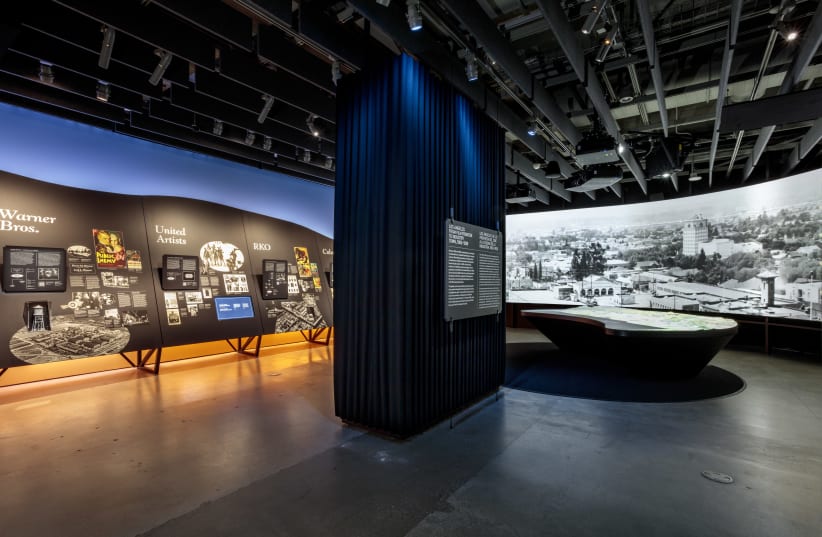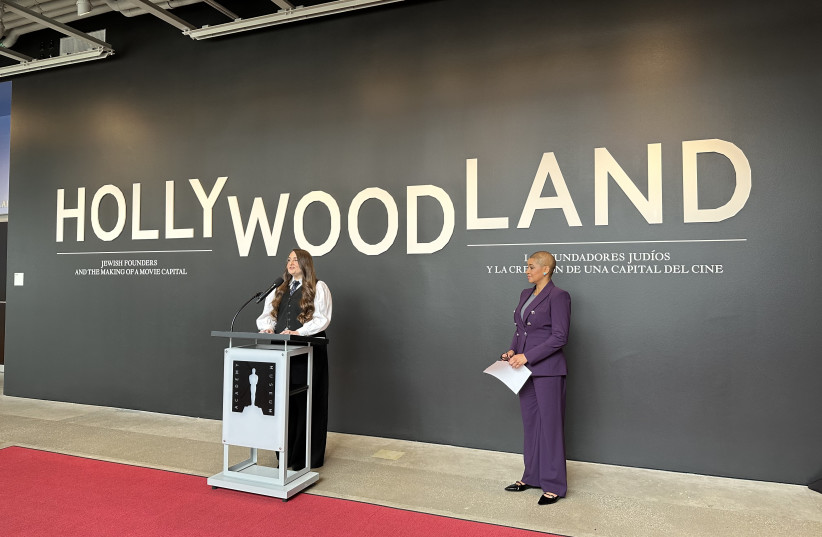Today’s understanding of Hollywood — the glitz, the glam, the red carpets and paparazzi — are a far cry from the film industry’s humble beginnings, when a group of Jewish immigrants from Eastern Europe laid the groundwork for what would become an epicenter of American and global culture.
Such is the story told by a new exhibition at the Academy Museum of Motion Pictures in Los Angeles, which opens Sunday. “Hollywoodland: Jewish Founders and the Making of a Movie Capital” traces the history and legacy of early 20th century Jewish Hollywood pioneers like the Warner brothers, Louis B. Mayer, Adolph Zukor and others. It is the museum’s first permanent exhibit.
The exhibit’s debut comes two and a half years after the museum’s opening, which sparked controversy among supporters and visitors for not including the industry’s Jewish beginnings.
Jacqueline Stewart, the museum’s director and president, told the Jewish Telegraphic Agency that community feedback helped the museum change its contents — and influenced its decision to make the exhibit permanent.
“I really feel that we’re able to present this exhibition now in a way that’s better than it would have been if we had tried to tell the story when we first opened,” Stewart said during a press preview. “Because we understand our audiences better.”
The “Hollywoodland” story
Dara Jaffe, the exhibit’s curator, said she held listening sessions and spoke to a number of rabbis and other members of the Jewish community both in Los Angeles and across the country to gather as much feedback as possible.
“I talked to every single person who reached out to me,” Jaffe said. “Anyone who called, emailed, I wanted to hear from them. And also, most importantly, we wanted a lot of eyes on this. We didn’t want anyone to be surprised by the content. We wanted people to know exactly what to expect, and to feel like their voices were heard.”
Stewart also pointed to the exhibit’s bilingual presentation — the displays all include English and Spanish — and its permanence as signals of the importance of the “Hollywoodland” story.
“That is providing a point of access to this story that we were not doing when the museum first opened,” Stewart said, referring to the Spanish-language offerings. “It’s from listening to a broad range of voices and coming to understand that we really need to be the place to tell this industry history. And this industry history is a story about Jewish immigrants and the world that they built in Los Angeles.”
For both Jaffe and Stewart, the new exhibition is also personal: Jaffe is Jewish, as are Stewart’s children.
“I have a lot of concerns about my kids, their safety, their sense of identity,” Stewart said. “I’ve been really encouraged by the way that this exhibition has come together, because I think that there are so many young Jewish people who will get a sense of pride from it.”
For Jaffe, highlighting the Jewish identity of each founder was an integral part of telling the story of Hollywood — particularly because of the influence of antisemitism on their careers.
“We’re looking at the way that a dominant culture of antisemitism not only shaped the way these Jewish founders were drawn towards the industry, but the way they were treated even after they were atop this industry that they built,” Jaffe said.
Jaffe, who had been working on the current iteration of the exhibit for more than two years, said she hopes it will serve as an educational resource, especially as antisemitism — including conspiracy theories about Jews running Hollywood — persists today.
“The same kind of antisemitic rhetoric that was leveled at these original Jewish founders of Hollywood, it’s still leveled at Jews in Hollywood today,” Jaffe said. “So to us, we are thinking about this as a very important educational platform to dispel these antisemitic harmful stereotypes, to offer some clarity and accuracy about why the founding of Hollywood is a Jewish immigrant story.”
The exhibit, housed on the third floor of the museum, contains three main sections. “Los Angeles: From Film Frontier to Industry Town, 1902-1929” features a digital topographical map of L.A. alongside a wall-length video screen depicting the city’s landscape and its progression, highlighting key landmarks that contributed to the growth of the film industry — from Warner Brothers Studios to influential Jewish sites such as Wilshire Boulevard Temple.
The second component, titled “Studio Origins,” is a long series of panels detailing the history of Hollywood’s studio system, spotlighting the eight studios known as “the majors” and their Jewish founders. In addition to archival documents, images of early studio lots, movie posters and behind-the scenes images from film sets, the displays mention each founder’s Jewish background.
In the section for Paramount, which was founded by Adolph Zukor and Jesse Lasky, the exhibit explains that “Zukor aimed to elevate the artistic status of movies to gain social respectability otherwise out of reach for a Jewish immigrant.” The idea of assimilation — and of raising the profile of an initially low-brow industry — are anchors of the exhibit.
The Warner Bros. display highlights Harry and Jack Warner’s “early stance against Nazism when polls and public discourse still conveyed this was an unpopular position in the United States.”
In the Universal installment, there is a 1938 letter written by studio founder Carl Laemmle, in which he emphasizes his concern for European Jewry. Laemmle would help hundreds flee Nazi Germany.
The third component of the “Hollywoodland” exhibit is a 30-minute documentary, “From the Shtetl to the Studio: The Jewish Story of Hollywood,” which traces the rise of the Jewish studio executives and their myriad impacts on the industry and on Los Angeles.
Narrated by TV host Ben Mankiewicz, the grandson of legendary screenwriter Herman Mankiewicz (the subject of the film “Mank”), the documentary follows the Hollywood pioneers from their humble beginnings as working-class immigrants through their steady rise to power, all while overcoming a deep-seated antisemitism that permeated both the United States and Los Angeles — from calls for boycotts and discriminatory real estate practices to antisemitic leaders like Henry Ford and Father Charles Coughlin.
The film also focuses on the studio founders’ desire to fit in during a time when assimilating was crucial to success in America. Louis B. Mayer, for instance, the co-founder of Metro-Goldwyn-Mayer studios, was born Lazar Meir, while fellow co-founder Samuel Goldwyn was born Szmuel Gelbfisz.
“The dream was to be assimilated and accepted as true Americans in their new country,” the documentary says early on. “The fear was that a dominant culture of anti-immigration and antisemitism would tear away their progress, keeping them marginalized, vulnerable and powerless. For this group of Jewish immigrants, these twin motivations drove the creation of Hollywood and combined into a force that could redefine their lives, and ours.”
The film also explores how, as the executives sought to depict their idealistic interpretations of “the American Dream” in their movies, that meant deferring to the cultural zeitgeist of the era, which oftentimes excluded or misrepresented women, people of color and members of the LGBT community. It also meant suppressing their own Jewish identities.
“This empire could be taken away at any moment by antisemitic forces that persistently questioned the Hollywood Jews’ admittance to America,” the documentary says. “If their Jewish identities became visible in their movies, they would suffer the consequences.”
For Jaffe, while the events of the past several months — namely Hamas’ Oct. 7 attack, the Israel-Hamas war and the reported global spike in antisemitism — didn’t influence the content of the exhibit, she said the current climate does accentuate the need for accurate storytelling.
“Unfortunately, antisemitism has always been prevalent and remains so, so this story always remains relevant,” Jaffe said. “There have been so many times throughout the last couple years where I wished that this exhibition was open so I could point to it and say, ‘if you’d like to be educated on this topic, please come to the Academy Museum, we’ll tell you exactly why.’ And so I’m just glad that it’s finally open.”

